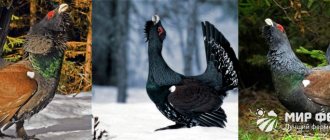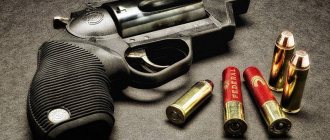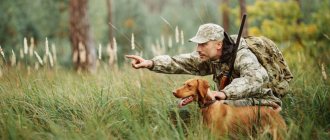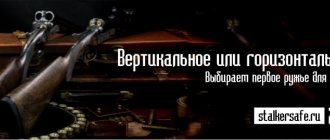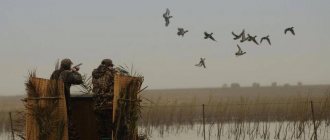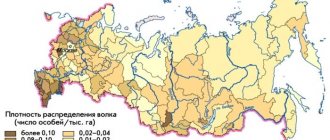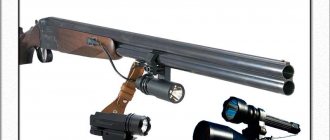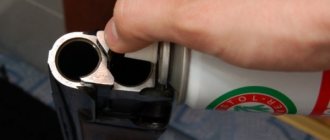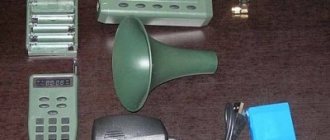Wood grouse shot for different cartridges
When deciding which cartridge and shot is best to use for capercaillie, first of all you need to clearly understand at what distance you will be hunting. Both the choice of shot number and the cartridge itself will depend on this. In addition, no one has canceled the rule that as the caliber number increases, the charge of the shot in the cartridge decreases. The classic cartridge for hunting wood grouse is 32. It allows you to confidently shoot a bird at distances of up to 45 meters. For longer distances it is better to use a Semi-Magnum or Magnum. The final choice of the cartridge itself must be made directly for a specific gun, taking into account its narrowing and other characteristics.
Important! When choosing a gun caliber, consider your body weight. For a person weighing up to 70 kg, a 20 or 16 gauge is better; the recoil from larger ones will be perceived as unpleasant. A 12-gauge shotgun will be comfortable to use for a hunter weighing over 80 kg.
The choice of fraction number will also be influenced by the time of year, but more on that below. Now directly to the calibers.
12 gauge
This is the most common caliber in our country. At distances:
- up to 30 meters, with the usual 32 cartridge, depending on the time, year, shot from No. 4 to No. 1;
- up to 50 meters, with a 32g cartridge or semi-magnum shot from No. 3 to No. 0;
- up to 60 meters, if the accuracy and sharpness of the gun allow, semi-magnum or magnum cartridge, from No. 2 to No. 00.
Check out the ranking of the best 12 gauge ammo.
16 gauge
Since a 16-gauge shot cloud will have less density, you can compensate for this by slightly reducing the size of the shot:
- up to 30 meters, with a conventional cartridge shot from No. 5 to No. 2;
- up to 45 meters, with a semi-magnum cartridge or magnum shot from No. 4 to No. 1;
- up to 60 meters, if the accuracy and sharpness of the gun allow, semi-magnum or magnum cartridge, from No. 3 to No. 0.
20 gauge
As they say in the hunting community, this is the choice of professionals. Most people recommend using a Magnum-type cartridge with this caliber for wood grouse, regardless of what kind of shot is loaded into it. Therefore, the picture here will be like this:
- up to 25 meters, starting with a regular cartridge and up to manum shot from No. 5 to No. 2;
- over 30 meters, if the accuracy and sharpness of the gun allow, magnum cartridge, from No. 4 to No. 0.
Important! When hunting wood grouse, there is no need to chase large shot sizes, especially if it is steel. Often fraction No. 0, No. 00, etc. rolls down with down or slides along the feather, causing injury to the bird, but without penetrating the body and the game escapes. For steel shot, this is also due to the fact that as the size increases, the weight of the shot changes slightly.
“Gun and cartridge” for hunting wood grouse
Capercaillie on a lek is a tempting spring hunt, quite rare in the middle zone
Photo: Sergey Naumov
The forest swindler is an enviable trophy. There are many fascinating stories surrounding the hunt for a bearded rooster. And how could they not appear when in the night spring forest the hunter’s heart no, no, and will shudder from the capercaillie “click”, and it will not immediately be possible to catch his breath in order to take the first hesitant step towards his dream under the “skirting”.
The spring hunt for wood grouse is perhaps one of the most prestigious hunts today, where the hunter has a significant role in obtaining the trophy. Apart from searching for currents, which in hunting farms is the task of the huntsman, everything else falls on the shoulders of the hunter. This is an incredibly exciting action in which a city dweller feels like a breadwinner, and not just a shooter.
However, hunting for wood grouse is not so difficult when the hunter is self-possessed and disciplined, and the forest is not cluttered - then the “jump” does not present any particular difficulty. Of course, a little luck doesn’t hurt, as does the ability to spot a capercaillie in the dense crown of a pine tree or among the branches of a spruce tree. But how great will be the disappointment when, after taking a correct aim from thirty to forty steps, a capercaillie, which seems modest in size in the pre-dawn twilight, falls from the tree with a roar, showing its true “dimensions”, quite comparable to the magnitude of the shooter’s disappointment, after, it would seem, an inexplicable mistake.
And the reason for a miss is often not a lack of shooting skill in difficult low-light conditions, but a lack of knowledge of the exact firing parameters of your gun and choosing the right cartridge.
To avoid any annoying mistakes, let’s first decide on the necessary ammunition. An indispensable parameter when shooting at a stationary target, in addition to the sharpness of the battle, will be the thickening of the shot scree towards the center.
Table No. 1 shows approximate ratios of the magnitude of the choke constrictions (ch.f.), the accuracy of the fire (C) and the concentration coefficients (K) for 12-gauge shotguns.
Table No. 1
To avoid a wounded person after a shot and not have to run in the dark, stumbling over twigs and bumps, after a shot capercaillie, it is advisable to have a K when using a standard cartridge (32 g) of 3.0–3.5 and, of course, an exact match of the center of the shot scree with the aim of.
For capercaillie, it is recommended to use shot from No. 3 (3.5 mm) to No. 0 (4.25 mm). For example, let's take a 32 g cartridge with shot No. 1 (4.00 mm). In total, the charge will contain approximately 80 pellets. Let's use a 16-lobe 750 mm target and the formula for calculating the thickening coefficient K = 3m/M, where m is the number of hits in the inner zone, M is the number of hits in the outer zone of the target, number three (3) is the equalizing coefficient for the number of internal lobes (4 pcs. .) and outer lobes (12 pcs.) of the sighting target. A bit of mathematics: with an estimated accuracy of the gun-cartridge system of 70%, we get 28 hits of shot No. 1 in the central (4 lobes) zone of the target, with a diameter of 37.5 cm, which, of course, will ensure a clean trophy with the correctly chosen aiming point. For shot No. 0, with the same initial number of hits, the number of hits will be 23-24, which will also be enough for a productive shot. What is meant here is not a shot at the most lethal place, which is also extremely important (for capercaillie and other birds, a shot from the side is more reliable than from the chest or from the tail, although you often don’t have to choose), but the alignment of the center of the scree with the chosen target.
For those who want to see how the number of hits in the central part of a 16-part target will change depending on the accuracy of C, the values of K, m and M, I suggest using the formulas: K = 3m/M; m+M=CN, where N is the total number of pellets in the projectile, and table No. 2, the approximate number of pellets in 10 g of shot depending on its size.
Table No. 2
We decided on the quality of the shot. The main thing is that the “gun-cartridge” system “produces” in the center (4 lobes, D-37.5 cm) the number of hits as standard 32 g at K = 3.0 and 70% accuracy. How this will be achieved - with the help of replaceable d.s., magnum (semi-magnum) cartridge or other means - does not matter.
But achieving the desired amount of shot in the center of the shot sheaf is far from a guarantee that the central part of the shot sheaf will accurately cover the target. To achieve an accurate hit, it is important to determine the deviation of the center of the scree from the aiming point.
The simplest and fastest, but, unfortunately, not the most accurate method is to fire a light bullet cartridge at a sheet with a designated aiming point. If you have a stencil and skill in handling it, the result will be better, but the stencil is more acceptable for small shot. If you have time and large sheets (about 1.0 x 1.0 m), then you can start calculating the exact center of the shot scree and do this preferably for the cartridge that you intend to use for hunting.
Using the example of the above standard cartridge with the same characteristics in the “gun-cartridge” system, let us consider how to find the deviation of the center of the scree. Two quantities will be important for us: the total number of pellets in the charge (N) and the approximate number of hits in the 750 mm target circle (a number close to m+M). Depending on the size of the sheet, if its area is significantly larger than the 750 mm target, we will focus on the number N, and for more modest sizes - closer to m+M.
Let's fire a shot at the designated center of the target. Let's cut off 15 hits (approximately 1/4 m+M) from the top of the shot scree with a horizontal line and the same number from the bottom of the shot scree. Next, we will perform similar “operations” with vertical lines to the left and right of the shot scree. In the rectangle obtained from the intersection of verticals and horizontals, we will draw diagonals, the point of their intersections will indicate the center of the shot scree. It is advisable to make calculations based on the results of several shots and change the parameters for each sheet, and in our case, for example, “cut off” 12 or 18 hits on each side.
Usually the test is carried out by shooting at 35 meters. Having found out the deviation at this distance, it is easy to estimate how the shot will fall: at 40–45 m or at 20–25 m.
If the deviation of the center of the shot scree is within 5–10 cm from the aiming point, then you should not “break your head” and aim without corrections. When this value turns out to be commensurate with half the central zone of a 16-lobe target, you will not only have to make adjustments in aiming at sitting game, but also figure out how to do this: depending on the distance to the target, or use heavy cartridges covering a larger area with shot around the aiming point. Of course, if the gun turns out to be capable of taking an increased charge of gunpowder and shot.
Yuri Konstantinov March 29, 2011 at 03:48 pm
Choosing a fraction relative to the season
When choosing shot depending on the time of year, there is a simple rule: the colder it is, the larger the size of shot you need to shoot. This is due to the fact that with cold weather, the density of birds’ feathers and down becomes greater.
Spring . During the spring season, the capercaillie, immediately after winter, has a rather hard feather, so it is recommended to use smaller numbers of shot, from No. 2 to No. 00, depending on the caliber and characteristics of the gun.
Summer . During the August hunt for mature capercaillie, you can use shot No. 6, No. 5, maximum No. 4. For the old wood grouse, fraction No. 4 or No. 3 will be enough during this period.
Autumn . During the autumn, the capercaillie gradually acquires feathers, and the young animals mature, and if it was possible to start the season with shot No. 6 - No. 4, then closer to winter it is worth switching to No. 3 - No. 1 or even No. 0.
Winter . At this time, when hunting on holes and others, it is worth using large sizes of shot, No. 1, No. 0, No. 00.
Wood grouse hunting tactics
For a successful hunt, a hunter needs to know not only how to catch game, but also its food supply, behavior patterns at different times of the day, in different weather. You should also take into account the annually changing feeding areas.
At the beginning of autumn, when there are a lot of berries, the capercaillie prefers to feed in the mornings in berry meadows, in clearings where lingonberries and blueberries are common. Even after the first snow falls, wood grouse continue to fly to their favorite berry meadows for a long time. However, before the snow falls, especially in the mornings, wood grouse can be found on sandy places and pebble shallows, where they collect small pebbles in order to feed on pine needles and tree buds in winter.
I have repeatedly observed that in the fall, when morning frosts set in and the day is clear, the capercaillie feeds intensively and flies from place to place. But in cloudy or rainy weather, he prefers to sit in the crowns of trees, hiding from the weather. I also noticed that in windy weather the capercaillie is more timid than in clear weather. Old males prefer to feed alone, but young males feed on whole broods of 2–3 pieces.
Before the hunt, a slight jitters begin. Once again I check the cartridges, the gun, the backpack. Everything is ready, all that remains is to wait for the long-awaited opening of the hunt. In the morning, getting up after dark, I throw my things and equipment into the car and drive out to the treasured clearing. At the end of summer, while picking lingonberries there, I noticed a small brood on the far edge of the clearing. As long as there is a berry, the capercaillie will feed on it. This winter, he most often sits on larches and fir trees, eating pine needles and buds.
Leaving the car a kilometer from the clearing, I throw on my backpack, load my gun and go out onto the forest road. In autumn, the capercaillie's plumage is denser than in spring. I use cartridges with No. 1 or No. 2 shot. I always load the cartridges myself, choosing the exact load of shot and gunpowder for my gun. This reduces the risk of a miss.
Having hunted for many years, I have always remembered the simple rules that help not only to hunt successfully, but also to remain safe and sound. These rules are known to all hunters:
Hunting for wood grouse with rifled weapons
The use of rifled weapons when hunting wood grouse has both supporters and opponents in the hunting community. According to the hunting rules, the use of such weapons when hunting wood grouse is permitted only from the end of August, during the autumn-winter period.
However, the use of rifled weapons in capercaillie hunting meets with a negative response among lovers of classic capercaillie hunting, with dogs or sneaking on a lek. Allegedly, it is not sporty, resembles poaching, leaves a lot of wounded animals, etc. There is some truth in this. But in general, this method of hunting has a right to exist, along with more traditional ones.
Shooting a capercaillie from a rifled weapon is successful and effective. Hunting is carried out from the approach, usually shooting from distances from 60 to 200 m. Hunting carbines of small calibers, 5.6 mm or 6.5 mm, are used. They are single-shot or semi-automatic, often with an optical sight. Since a bullet of this caliber is quite light at a high initial velocity, it has a good flat trajectory. But the wind deviation of 100 m can be quite large. Therefore, such a hunt requires high shooting skills.
Hunting for wood grouse (according to Sabaneev)
Spring hunting for wood grouse
In the spring, as you know, there is almost only one way to hunt wood grouse - from the approach.
This hunt is based on the fact that the current capercaillie, making the last trill of its “song,” has difficulty hearing and seeing. At this time, you can jump up to him and even miss him. Wood grouse begin mating in the southwestern provinces around the first days of March, in the middle ones - around the middle, and in the northern and northeastern ones - at the end of March or even at the beginning of April and continue until mid-May. The real approach hunting begins, however, two weeks after the start of mating, since in March there is still a lot of snow and wood grouse do not mating very quickly. It is best to hunt alone or, in an unfamiliar place, with a guide - a local industrialist, or even more conveniently - a forest guard - a non-hunter. If you cannot spend the night in the forest, not far from the current, then you need to be near the current half an hour before dawn. Currents occur in the same places year after year, and therefore it is necessary to look for them very rarely, and questions and instructions from conductors are sufficient. However, it is sometimes possible to determine the location of the current by the direction of flight of flying capercaillie, and in early spring by the tracks left by males in the snow. We must always keep in mind that if there is a moss swamp with pine trees in the forest, then capercaillie mating either in the swamp itself or on its outskirts. Where there are no msharins, there are currents near swamps and lakes - inside the forest, but always far from the edge of the forest, roads, and even more so from villages, even housing, in the form of a forest guardhouse. For these reasons, it is more prudent to come to the current in the evening and spend the night nearby, building a fire - but no closer than a quarter of a mile from the current. This is all the more convenient because you can inspect the latter in advance, get your bearings, listen to where the wood grouse crow, look out what trees they sit on, where the wood grouse skir (or grunt), and sometimes, at the very height of mating (mostly in the second half of April), even jump up to the displaying male.
The weather condition, especially during the first mating period, is very important: in March and early April one cannot be completely sure that the wood grouse will sing well tomorrow. In severe frosts and generally before a sudden change in weather, wood grouse only grunt—skirmish, without making a trill. Morning grunting always portends failure, and in general, it is young males who do not sing who grunt most often, and the grunting itself is often an alarming cry emitted at the sight of a person, animal or other danger. When traveling long distances, it is obviously useful to take into account the barometer readings.
It is best to hunt on leks with a guide who will carry the killed birds, but on the lek itself you need to walk alone. It’s not worth going to small leks, where less than a dozen wood grouse lek, with a friend; large ones can be hunted by two or three at a time, but it is necessary to agree in advance who should go where and which side to stay in, so as not to interfere with each other, and in no case should you stomp or call to each other before the end of mating. In case of spending the night in the forest, you need to dress warmly - in winter, with felt boots in reserve, a warm blanket or burka. More often you have to jump up to wood grouse in large waders, but if the current is not very damp and the hunter is not afraid of a cold, then it is more convenient to approach in felt boots even in warm weather. When there is still deep snow in the swamp, you can approach either on crust or on skis.
Depending on the temperature, to walk on the current you need to wear a short winter caftan or a padded jacket and more or less thick trousers. At the same time, both clothes and felt boots must certainly be gray.
Having arrived at the site of the current, you need to wait a little to see if a capercaillie will flood nearby. In general, you shouldn’t walk around in vain, call to each other, or even smoke; then they begin to search, trying to walk as quietly as possible, stopping and listening every 20 steps; and, of course, the direction of the wind is very important. If possible, try not to walk with the wind, but against it or half the wind. In calm weather, the clicking (tecking) of a capercaillie can sometimes be heard 200 steps away, and the fighting, chirping, a little further.
When the nearest capercaillie hits you for the first time, you should not sneak up on it. Only when he begins to trill can you first quietly approach him, hiding behind the trees, and then jump up. At first, it is best to approach in the direction from west to east, since in the whitened sky the capercaillie is more visible and, moreover, then it is less likely to have to shoot it in the crop and there is less chance that the bird will see the hunter. They usually begin to jump, already 80-100 steps away, rarely less, except in the dark or in windy weather; when it is completely dawn and the wood grouse are frightened, it does not hurt to take precautions at a greater distance. The closer the peak of the current is, the more vigorously the bird plays, the hoarser its flight, and, consequently, the older it is, the greater the likelihood of success. If the capercaillie begins to deceive, that is, stop before the trill, or even becomes silent - sometimes for 15 minutes, which means that he heard or saw a hunter, he must hide behind a tree, or petrify in place and patiently wait for the real game - or abandon this probably already shot bird and begin approaching another. However, some industrialists, in order to provoke such a sensitive male, use, not without success, many nooses, such as, for example, clucking with a grouse or egging him on by scraping and hitting the barrel of a gun with a knife and imitating these trills. Sometimes wood grouse even fly up to this kind of decoy. There are wood grouse that constantly change place and, having sung two or three times, fly over, although not far. You should not approach such birds, and in general, if the current is large, it is better not to approach a once hunted male and look for another. A capercaillie that has been made noise twice will never be allowed to come a third time.
The most difficult thing in this spring hunt is the approach, or rather the jumping, especially when the place is too open and there is nowhere to hide. It is better to choose the longest path if it provides great convenience, that is, it has trees that would shield the hunter from the wood grouse, and is devoid of large snowdrifts, holes and piles of dead wood. As soon as the capercaillie speeds up its tapping and starts real clicking, you need to be ready to jump: at the first skirmish, the hunter rushes headlong forward, makes two or three huge jumps and stops dead in his tracks, if possible before the bird finishes clicking, since sometimes the echo of the last footsteps might disturb her. There is nothing to make out here - you fell into the water or snow, and you need to stand motionless until the next battle, trying to determine in advance the direction and the very place of future jumps, so as not to get into an even more awkward position again. During the last jump, it is necessary to push through the ice, weak crust or dead wood hidden under the snow under your feet.
For the most part, you have to shoot very close - no further than 50 steps, firstly, because in the dark it is difficult to see a bird, especially one sitting on a spruce tree, at least 10 fathoms away, and secondly, because the current capercaillie, inflating its feathers , is very strong against a shot: if you aim at the crop, then an insufficiently large shot will even bounce off or easily wound the bird. For all these reasons, it is more correct to strike 15-20 steps from the tree on which the capercaillie is sitting, and if it is not visible or is blocked by thick branches, then it is better to go around it on the other side.
Having seen where the capercaillie is sitting and choosing a place convenient for shooting, the hunter can only shoot. However, even here a lot of very special skill is required. Firstly, you need to cock the hammers (they always jump when they are released), raise the gun and take aim without fail while firing, sometimes even in two steps, i.e. pull the trigger already at the next chirping sound; secondly, do not lower the gun after firing and do not move away. This is done with the purpose that in case of a miss, it would be possible to shoot another time, loading the gun during the next display, since during the skirmish, the capercaillie no longer pays attention to the shot and does not fly away, sometimes even receiving a slight wound. Only when another capercaillie is wandering nearby (usually a distance of about 100-150 steps), it is better to shoot at the one you are approaching, while the neighboring one is “hooking”, so as not to frighten it off. Mistakes here are very possible; out of habit and in the dark, it’s no wonder to shoot at a very close distance: branches interfere with the accuracy of the shot, too hasty and incorrect aim; In addition, we must not forget that at dusk (as well as in moonlight) it is necessary to change slightly higher. The capercaillie, during its “game”, is very susceptible to wounds and often, with its belly shot through even by a rifle, flies out of sight - for several tens, more than a hundred steps and then still manages to run a few times along the ground, so that it is impossible to find it dogs are quite difficult. Therefore, it doesn’t hurt to take with you at least a simple mongrel, trained to look for wood grouse, and leave it on a leash at the lodging house or with the handler until the end of the current.
As for the gun, the most suitable for this hunt is a small-caliber rifle, 320 caliber, a little more or less. For those who know how to shoot a bullet, a rifle is indispensable for any shotgun, since, firstly, it can be used to shoot successfully at a distance of 100 steps or more, and, secondly, the sound of the shot does not frighten males walking nearby. In any case, for the capercaillie, a bird that is very susceptible to wounds, especially in the cold, you need a shotgun, double-barreled or single-barreled, with a very strong large shot, like a shotgun, so that you can confidently shoot at a distance of 60 steps. The old Swedish long single-barreled rifles were very good for wood grouse hunting. Of the double-barreled guns, the most suitable are shotguns (12 or 10 gauge), used in round-up hunts and in pigeon cages, generally with a strong and sharp fire. Some prefer chokes, others, who have cylindrical drill guns, resort to concentrators to enhance the fight. It is only necessary to shoot the gun in advance and determine what number of coarse shot it shoots best and carefully prepare the cartridges yourself. Usually they hit wood grouse with No. 1 shot, but some prefer No. 0, and others No. 2. For the sake of greater sharpness of the battle, you can slightly reduce the charge of the shot against the norm.
The capercaillie is very tough on wounds and, when aiming at the crop or chest of a displaying male, it is almost impossible to kill him unless you hit him in the head: the shot bounces off the puffed up feathers. Therefore, you need to aim at the side or shoulder, and if such an aim is impossible, then it is more prudent to jump a few steps to the side. When shot in the rear, a capercaillie almost always flies away, seriously wounded. A wounded capercaillie is easy to distinguish from an unwounded one: the first flies straight down and tries to fly in a clean place - a clearing, a clearing and mostly sits on the ground; the second rises upward, flies higher and further, always lands on a tree and, moreover, higher than before, often near the very top and sits “alert”, that is, on guard, almost without leering, so that it is much more difficult to approach it. There are cases, however, when lightly wounded people sit on the tops and continue to talk.
Hunting capercaillie broods with a dog
The hunt also begins in mid-July and ends in the first or second half of August. This hunt requires first of all a good dog, and then familiarity with the area and the habits of the game. The dog should not be led astray from the direction it has chosen; it should not be rushed in the search, vodka and stance. It is necessary to watch how the dog leads: in one straight direction or in circles, that is, constantly returning to its old trail. In the first case, the dog must be given complete freedom to act; in the second, she must be hurried, because in circles she follows the trail of an old capercaillie, who is too lazy to get up and tries to confuse the hunter and the dog, forcing them to return to the same place several times; thus confused, he rises outside the shot. You need to patiently wait for the game to fly out and always keep your gun ready in case of its sudden flight. Rising game should be released within range of a sure shot, but only if the terrain allows it; where the vegetation is dense and frequent, for example, in bushes and moss forests, you cannot wait for a bird to appear somewhere in the clearing, but you need to shoot at the place where you can hear the flapping of the wings of a flying game, even if it itself was not visible. Only in this case, hunting acumen is certainly needed, that is, the hunter must be able to quickly and correctly aim, quickly and correctly determine the place where the flapping of wings occurs, must know what kind of game and at what height takes off from the ground. Not every such shot will be successful, but there is still less chance of missing the prey than if you wait for it to fly out to a clear place when it is already out of the shot.
The dog should not be allowed to chase after rising game and rush to the killed one, because the litter sometimes rises more than once; the dog, rushing after the game, scares the brood, raises it in vain, as a result of which the hunter, not preparing for the shot, misses or lets the game go without firing.
A hunter should also not rush to approach a dead bird with an unloaded gun; often the bird is only stunned by the shot, but when a person approaches, it comes to its senses and instantly flies away. Having released the charge, you should first of all replace it with a new one, and then go to production.
Autumn shooting from the entrance
Such hunting is convenient in those corners where roads pass through large forests or are adjacent to the edges of forests. It is based on the fact that wood grouse in the fall, as soon as the leaves begin to move, like to fly out onto the roads in the mornings and evenings, walk along them and peck sand on them. If wood grouse are not frightened, they will remain on roads or near these places all night, especially where forest berry fields are adjacent.
For this hunt, it is necessary to leave at dawn in order to be already in place before sunrise. You need to walk along the road at a pace, without any noise and without dogs, and look more closely at it and at the surrounding trees. It often happens that wood grouse run in front of a horse and give the hunter the opportunity to stop and shoot at the running ones. This happens mainly at a time when it is barely beginning to get light. It happens, however, that you can run into running wood grouse even when the sun has already risen, but then they soon rise and sit on the nearest trees, and if they are frightened, they fly away completely or sit far away and often at the edge of the roadside, where they cannot be reached by car. crew and have to make their way on foot. Where few wood grouse are shot in this way, the hunt is successful, because they get used to ordinary passers-by and are not afraid of them at all, so that, having let their companions pass, they immediately fly back onto the road and run along it.
Shooting wood grouse in an aspen forest
From the second half of August, wood grouse begin to fly out to aspen forests at dawn and eat aspen leaves; Mostly young people fly out, having already moved to the mature pen by this time; Old capercaillie fly out with them, but you only see old roosters in aspen forests in September.
Hunting “in aspen forests” is done in two ways. If there are few aspen trees in the forest and they are spaced apart from each other, or a group of aspen trees (tall) are located at a great distance from each other, then the hunter, an hour or two before sunset, comes to the aspen trees known to him and sits down in such a way that the aspen trees are clearly visible, and the gun would reach the wood grouse sitting on them. There is no need to particularly hide in such an ambush.
Wood grouse begin to fly out when the sun goes down behind the forest, and sometimes a little earlier, often singly, but quickly, one after another, young ones earlier, old wood grouse later. Having arrived, wood grouse noisily sit in the middle of the aspen foliage and sit motionless for some time, but not for long. If a hunter missed the arrival of a capercaillie and did not notice the place where he sat down, then he should not get up or walk around to look at the bird. The capercaillie, which has become sore, will soon become very busy in the foliage, will walk along the branches to the outer branches, immediately starting to pinch the leaf and swallow it; tearing off a leaf, it produces a noise similar to the falling of large drops of rain, which occurs from tearing off leaf cuttings; the habitual ear can discern this clicking sound three hundred steps away. Young wood grouse usually fly out silently, but old wood grouse cluck.
Noticing a sitting capercaillie, the hunter immediately shoots at it and quickly picks up the dead one, or, better yet, loads the gun without leaving his spot. The next ones fly after the first one, one after another - and the hunt continues until darkness. It happens that in the second half of August, in this way, without leaving the spot, an entire brood is killed, which was not broken and therefore still held together. If the hunter did not have time to shoot at one wood grouse and at that time several of them flew out, then he must let everyone sit down and shoot when everyone moves, shooting first at those sitting below. Frightened wood grouse do not fly away from shots, but hide after each shot.
The second method of hunting “in aspen trees” is used in areas where aspen trees are scattered over a large area; it consists of the hunter walking through the aspen forest, listening to the noisy landing of wood grouse in the foliage, and later to the clicking of a torn leaf. Hearing a capercaillie, the hunter quietly approaches it and, having noticed it, shoots. This second method is much more interesting than the first, but it is incomparably more difficult to spot a capercaillie from the approach, especially since it hides if it hears or sees a person; he always flies off the aspen tree extremely reluctantly. It is best to shoot wood grouse on this hunt with the first or second shot number.
Hunting for wood grouse through larches
This hunt is practiced in northeastern Russia, in the Ural Mountains and Siberia, and has many similarities to the one described above. At the end of August or at the beginning of September, after the first cold mornings, the larch needles “turn sour” and from that time on they serve as the main food of the black grouse here, until the first days of October, when the needles turn yellow and fall off.
At first, wood grouse sit on larch only at sunrise and sunset and sit for an hour or an hour and a half, which is why the real hunt begins in mid-September, when wood grouse sit from 3 a.m. to ten, and from five in the evening until night (generally in the morning before sunrise, after noon - three hours before sunset), and at the end of September - the whole day. The success of the hunt depends a lot on the weather: on clear and windy days the bird is very strict and doesn’t let you in; on the contrary, on a cloudy, cool and slightly rainy day the bird is quiet, sits longer and lets you in closer.
Hunting is carried out in two ways: with a dog (laika) or stealth, without a dog. The dog must find the bird with its upper sense; the one that finds it by “eating”, that is, by the needles dropped by the wood grouse while eating, is not valued particularly highly, and the one that barks very loudly and often, especially if it jumps up a tree, is no good. Having found a capercaillie, she begins to bark; The capercaillie concentrates all his attention on her, lowers his head down and moves away, as if he is angry and teasing the dog. It is not difficult for a hunter to approach him within 30 fathoms or even closer, so that he can kill him with a rifle. In case of a miss, you can safely load the gun again: a young capercaillie is not afraid of a shot and it happens, especially if you shoot at an unafraid bird, that you can fire up to ten or more shots at it. A bullet flies close over your head, it falls as if stunned on a branch, and you can shoot at it several times. But if the bullet drops, it is usually removed. Sometimes, after a shot, a capercaillie will run along a branch, jump to another, and only when it sees a hunter or hears an overly suspicious noise, it moves to another tree; however, it rarely flies further than one mile. Having moved, the capercaillie becomes more careful. It should be noted that the capercaillie can withstand the barking of a dog for a very short time, and therefore on larch, as on aspens, for the most part only males have to be killed.
Hunting without a dog is much more difficult. The hunter must look out for the game himself, which, despite the significant size of the bird, is very difficult, because the capercaillie very skillfully hides between thick tree branches, and the distance is enormous. It is even more difficult to see a capercaillie, especially when it sits close to a tree trunk. You need to sneak up more carefully, otherwise you risk scaring off the bird. In the early morning, however, wood grouse often display on larches (also on aspen trees in central and northern Russia), and then you can jump up to them for a shot from a shotgun, just like in the spring.
Rifled cartridge
When deciding which rifled weapon to shoot with, you first need to know which caliber will be preferable to you. Usually small-caliber rifles, rifles chambered for 5.6x39, 5.56x45 and 6.5x55 are used for hunting wood grouse. Let's take a closer look at the most popular cartridges.
223 rem
This 5.56x45 cartridge was created as a civilian, hunting version of the standard military 5.56x45 NATO ammunition, and differs only in a thinner case. This cartridge is considered optimal for hunting capercaillie, other upland game and small animals. It has low recoil and is capable of hitting birds at long distances, allowing you to shoot accurately at 250 m without any problems. When hit, it leaves almost no wounded wounds, killing wood grouse with the first shot.
In our country, similar 5.6x39 mm hunting ammunition known as .220 Rus was developed.
22 lr.
When hunting with small guns, this is the ammunition that is used. This 5.6x15.6 mm rimfire cartridge was developed back in the century before last and is well known for its use in TOZ-8, TOZ-16, MC-18 rifles, etc. The target firing range for it is about 140 m, but they are usually fired at distances up to 100 m.
When hunting wood grouse, the disadvantage of such a cartridge is that it leaves wounded animals. When shooting with such ammunition, you need to aim at the neck or under the wing, because when it hits the chest, the capercaillie hides from the place of injury and it is not always possible to find it.
Winter
I can’t boast about winter wood grouse hunting. We did not go north at this time. In our lands, hunting for upland game was allowed until November 1, after which permits were issued only for hare. Of course, we saw wood grouse. There were many holes in the snow, especially in February during the survey along the “winter trail.” And once a wood grouse even spent the night at my dacha. Throughout my entire practice, I only managed to get two roosters when I lived in the Northern Urals
At the end of November I trained a young hound. To prevent the dog from getting confused, I chose places where there were few hare tracks. Early in the morning I got off at a small station and went deeper into the forest. There was snow up to about half a felt boot, so I found it more convenient to move along the sled road. The capercaillie swooped down unexpectedly - however, this often happens. He was flying high, and at first I even mistook him for a koscha. After the shot, the rooster began to fall onto its left wing and disappeared behind the forest. I set a course according to the compass so as not to get lost, and headed out to look for the wood grouse, or at least its traces. He had walked quite far when he heard the flapping of wings and hurried towards the sound. The young dog pressed the rooster and, like a hare, grabbed him by the back. I drove the dog away and began setting up the camera. The exposure meter showed that there was not enough light. I decided to wait until dawn. Suddenly, stretching his neck, the capercaillie began to run. In one leap the dog caught up with him, grabbed him by the neck and crushed him. And that I didn’t take it off, even with a long shutter speed? I had to be content with a still life. How did a young hound, actually a puppy, figure out that he needed to chase a capercaillie - the question is?
Many years later I visited my brother. We decided to take a walk in the forest. My brother took his teenage son with him to teach him how to shoot a gun. I separated myself from them somewhat. I heard a shot and saw a capercaillie flying above me. He shot after him with buckshot and realized that he had hit him - the rooster stopped flapping his wings, he was just gliding. In search of traces (or a trophy), my brother and I separated; my son walked between us. "Found!" – we heard a joyful cry. The beaten capercaillie lay motionless, buried in the snow. At home, the boy excitedly told his grandparents how he found the prey.
Hunting for wood grouse with pneumatics
Nowadays, air rifles have long become serious hunting weapons. Their advantage, in particular when hunting capercaillie, is a much quieter shot, high accuracy and no misfires. Plus low cost per shot. This is a quiet, high-precision instrument. Disadvantages include the low weight of the bullet and its sensitivity to wind. Also, the susceptibility of such weapons to external factors, such as dirt, sand, etc.
Important! Pneumatic weapons, starting with caliber 6.35, are subject to registration on the same basis as firearms.
Rifles with a caliber of 5.5 mm or more are suitable for hunting wood grouse, but it is better to take 6.35 or 9 mm to reduce the risk of being wounded.
Specific to application:
- The 5.5 mm works reliably against capercaillie at distances of up to 50m, but you need to shoot in the head to be sure. When hit in the body, the bird often leaves. JSB Exact and H&N Baracuda bullets performed well.
- 6.35 is the most suitable caliber, it works quietly up to 120 m, with an energy of up to 140 J. They shoot in the head, base of the neck, under the wing. The H&N Baracuda 6.35, JSB KING and heavy Eun Jin bullets showed high accuracy.
- 9 mm gives a confident kill to the bird when hit. Energy 130 – 160 J. It is better to shoot at the base of the neck or under the wing. Eun Jin and H&N Baracuda 9 bullets.
The following conclusion can be drawn. If you prefer classic hunting, then a double-barreled shotgun or a 12-gauge shotgun with a long barrel will be optimal for you. If shooting skills are preferable for you, then the best choice would be a self-loading rifle chambered for 223rem. To some extent, a replacement for rifled weapons can be pneumatic weapons of 6.35 caliber.
Hunting for wood grouse in autumn from the approach
From the name itself it becomes clear that hunting consists of approaching the wood grouse at a distance that allows you to make a successful shot.
The hunter needs to dress in camouflage clothing that will be similar to the environment, because the capercaillie has good eyesight.
It is better to choose cloudy weather when the leaves in the forest do not rustle, which will make it easier to approach the bird. You need to go to places where aspen and larch grow. If there is wind, then it must blow towards the hunter, and not away from him.
As a rule, in a pine forest there are small islands of aspen or larch, which are located on the southern slopes.
The presence or absence of wood grouse in such places can be determined by the dried needles lying on the ground. In addition, during the fattening process, birds throw small twigs and leave droppings under the tree where they feed.
When a capercaillie flies up a tree, the flapping of its wings can be heard for several hundred meters, and the clicking sound while tearing off leaves can be heard for a couple of hundred meters.
Thus, the hunter will be able to determine where the wood grouse are currently located, and then begin to approach them.
If several wood grouse are sitting on a tree, then you need to shoot those who are lower so as not to frighten off the rest. You should aim at the side under the wing with shot No. 2 or No. 1.
It is recommended to use a 12 gauge weapon. If you use semi-automatic devices, then preferably with a weight of no more than 3.3 kg.
When hunting wood grouse in the fall, other methods are used. For example, hunting with stuffed animals, when three to five stuffed capercaillie are planted on a tree, they build a hut and wait for their arrival.
Some hunters drive up to a capercaillie in a car and shoot directly from it, but this is an illegal way of hunting. Such moments happen when wood grouse are looking for pebbles near roads.
Hunting dates
Hunting for wood grouse is one of the most interesting spring hunts. And the timing of the lek hunt usually coincides with the timing of other hunts: hunting for drake, woodcock and goose.
In each region, certain dates for spring hunting are established, for example, here in the Kirov region, spring hunting in the southern regions lasts for 10 days and is usually set from the beginning of the last week of April to May 4. In the northern regions it is set in the 1st decade of May. But everything depends on weather factors, and in some years the timing of the spring hunt shifts slightly.
